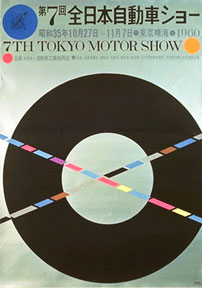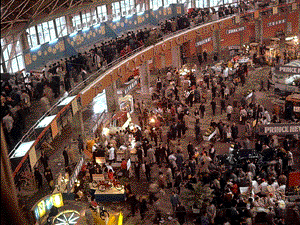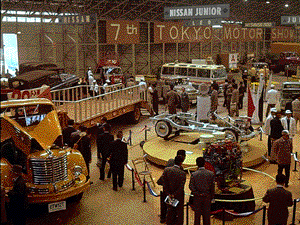 |
 |
 |
The
7th Tokyo Motor Show (1960
. 10/25 - 11/7)
 |
 |
| The 7th Tokyo Motor Show Poster |
A month before the Show, the Road Transport Vehicle Act
was revised, and the definition of a small car was changed
from "up to 1500cc" to "up to 2000cc." JMIF provided visitors
with "Digest of the new RTVA" and held an essay contest
on "How New Road Traffic Should Be."
The industry saw some major changes in this year. First,
an imported car show was held at Enoshima Kaigan in Kanagawa
Prefecture, as though competing with the all Japan motor
show. This must have gotten the attention of the Japanese
automakers, as the general public had a deep-rooted admiration
for foreign cars in those days. Furthermore, the industry
was severely shaken by the government s announcement that
it sought to liberalize trade and exchange-rate transactions
by 80%, in three years. The automobile industry was seen
as one of the industries most vulnerable to damage from
liberalization. Especially passenger cars, due to small
production volume, were not competitive with foreign cars
in cost let alone quality and performance. The 7th Motor
Show thus featured beautiful young women at each showy
exhibitor, to better compete with foreign makes.
|
 |
 |
 |
The exhibits numbered 358, far more than the previous show, reflecting the liberal mood. One highlight of the Show was Toyota s exhibit of the Publica show car with its catch phrase, "Everybody s Car." The four-seater equipped with a 700cc air-cooled engine and priced at ¥389,000 was called a $1000 car ($1=¥360 at that time), and attracted much attention. Toyota also announced its second generation Corona "PT20" with the catch phrase "All new except the tires." Nissan introduced the "Cedric" with four headlights, a product springing from the technical tie-up with Austin. Fuji Precision Machinery marketed the four headlight "Gloria," and Toyo Kogyo presented a midget car with four-wheel independent suspension, the "Mazda Coupe," at the low price of ¥310,000. Fuji Heavy Industries developed "450" to follow "360." Every manufacturer showed great enthusiasm in "taishusha," or mass-market cars. Price competition was tough amid the new models as the automakers were conscious of liberalization. This show was characterized by an increase in passenger models sold on ¥500,000 level. Visitors numbered 812,400, a large increase over the previous show s 653,000.
|
 |
|
|
|